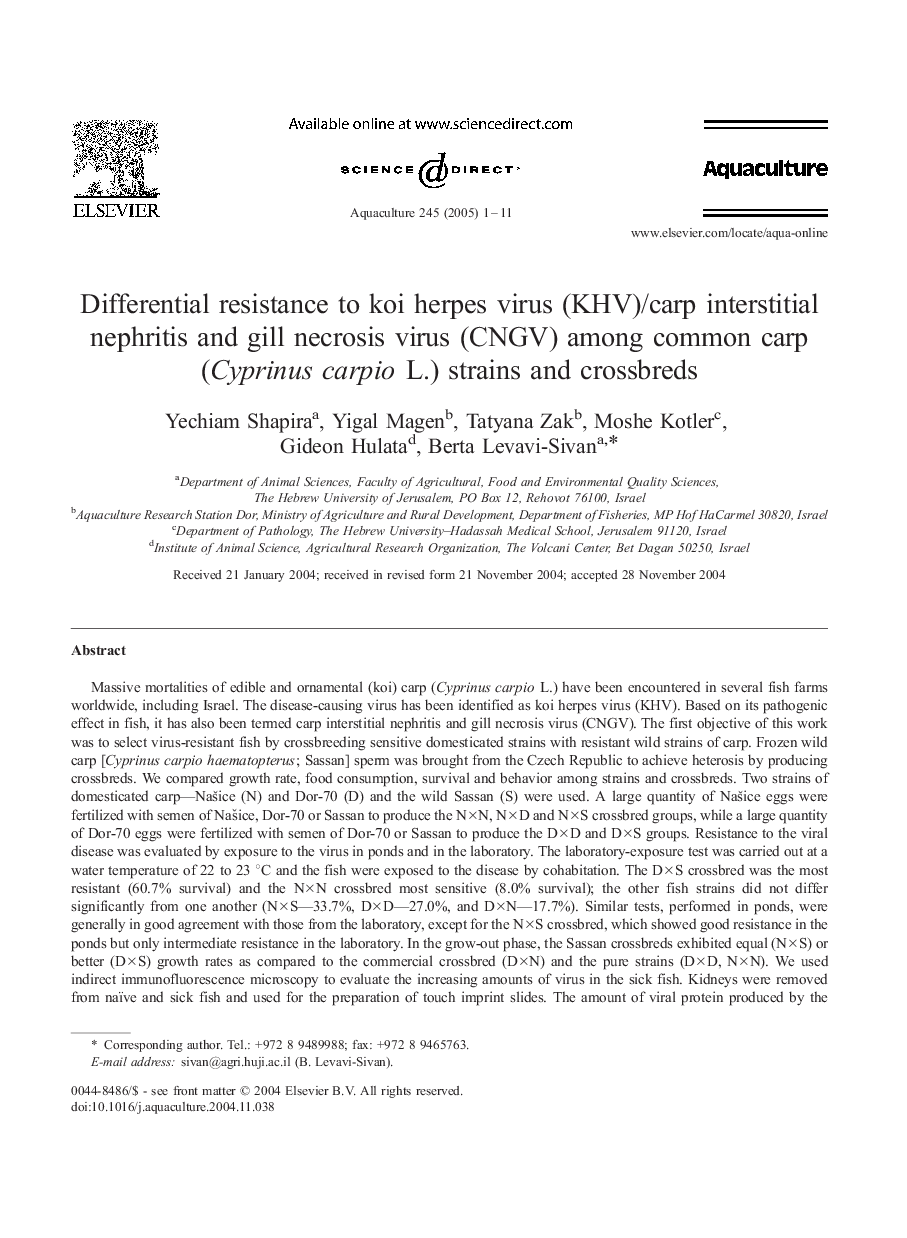| کد مقاله | کد نشریه | سال انتشار | مقاله انگلیسی | نسخه تمام متن |
|---|---|---|---|---|
| 8974771 | 1552997 | 2005 | 11 صفحه PDF | دانلود رایگان |
عنوان انگلیسی مقاله ISI
Differential resistance to koi herpes virus (KHV)/carp interstitial nephritis and gill necrosis virus (CNGV) among common carp (Cyprinus carpio L.) strains and crossbreds
دانلود مقاله + سفارش ترجمه
دانلود مقاله ISI انگلیسی
رایگان برای ایرانیان
کلمات کلیدی
موضوعات مرتبط
علوم زیستی و بیوفناوری
علوم کشاورزی و بیولوژیک
علوم آبزیان
پیش نمایش صفحه اول مقاله

چکیده انگلیسی
Massive mortalities of edible and ornamental (koi) carp (Cyprinus carpio L.) have been encountered in several fish farms worldwide, including Israel. The disease-causing virus has been identified as koi herpes virus (KHV). Based on its pathogenic effect in fish, it has also been termed carp interstitial nephritis and gill necrosis virus (CNGV). The first objective of this work was to select virus-resistant fish by crossbreeding sensitive domesticated strains with resistant wild strains of carp. Frozen wild carp [Cyprinus carpio haematopterus; Sassan] sperm was brought from the Czech Republic to achieve heterosis by producing crossbreds. We compared growth rate, food consumption, survival and behavior among strains and crossbreds. Two strains of domesticated carp-NaÅ¡ice (N) and Dor-70 (D) and the wild Sassan (S) were used. A large quantity of NaÅ¡ice eggs were fertilized with semen of NaÅ¡ice, Dor-70 or Sassan to produce the NÃN, NÃD and NÃS crossbred groups, while a large quantity of Dor-70 eggs were fertilized with semen of Dor-70 or Sassan to produce the DÃD and DÃS groups. Resistance to the viral disease was evaluated by exposure to the virus in ponds and in the laboratory. The laboratory-exposure test was carried out at a water temperature of 22 to 23 °C and the fish were exposed to the disease by cohabitation. The DÃS crossbred was the most resistant (60.7% survival) and the NÃN crossbred most sensitive (8.0% survival); the other fish strains did not differ significantly from one another (NÃS-33.7%, DÃD-27.0%, and DÃN-17.7%). Similar tests, performed in ponds, were generally in good agreement with those from the laboratory, except for the NÃS crossbred, which showed good resistance in the ponds but only intermediate resistance in the laboratory. In the grow-out phase, the Sassan crossbreds exhibited equal (NÃS) or better (DÃS) growth rates as compared to the commercial crossbred (DÃN) and the pure strains (DÃD, NÃN). We used indirect immunofluorescence microscopy to evaluate the increasing amounts of virus in the sick fish. Kidneys were removed from naïve and sick fish and used for the preparation of touch imprint slides. The amount of viral protein produced by the infected kidney cells was high, enabling detection of the infected cells as early as 3 days post-infection. Thus, a simple imprinting immunofluorescent assay may be appropriate for CNGV diagnosis.
ناشر
Database: Elsevier - ScienceDirect (ساینس دایرکت)
Journal: Aquaculture - Volume 245, Issues 1â4, 4 March 2005, Pages 1-11
Journal: Aquaculture - Volume 245, Issues 1â4, 4 March 2005, Pages 1-11
نویسندگان
Yechiam Shapira, Yigal Magen, Tatyana Zak, Moshe Kotler, Gideon Hulata, Berta Levavi-Sivan,